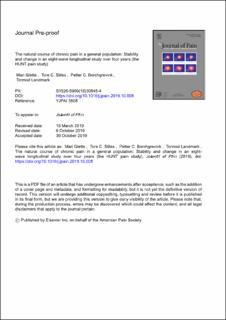| dc.contributor.author | Glette, Mari | |
| dc.contributor.author | Stiles, Tore C | |
| dc.contributor.author | Borchgrevink, Petter Chr. | |
| dc.contributor.author | Landmark, Tormod | |
| dc.date.accessioned | 2021-09-27T09:43:09Z | |
| dc.date.available | 2021-09-27T09:43:09Z | |
| dc.date.created | 2020-12-21T11:27:46Z | |
| dc.date.issued | 2020 | |
| dc.identifier.citation | Journal of Pain. 2020, 21 689-699. | en_US |
| dc.identifier.issn | 1526-5900 | |
| dc.identifier.uri | https://hdl.handle.net/11250/2783685 | |
| dc.description.abstract | Epidemiological studies have to a little extent addressed the potential fluctuations of chronic pain over time, and there is a lack of information about the long-term course of pain using repeated measurements. We wanted to identify different trajectories of pain during 8 waves of follow-up over 4 years among individuals in the general population reporting pain lasting at least 6 months at baseline. Secondarily, we wanted to investigate whether biopsychosocial factors at baseline were associated with the different pain trajectories. Longitudinal Latent Class Analysis was performed to classify a random sample of 1905 participants from a larger population-based study (HUNT3) into groups based on their longitudinal pain severity reporting. A five-class solution gave the best fit. The terms chosen to describe the pain trajectories were: “fluctuating” (n = 586 [31%]), “persistent mild” (n = 449 [24%]), “persistent moderate” (n = 414 [22%]), “persistent severe” (n = 251 [13%]), and “gradual improvement” (n = 205 [11%]). In a multinomial logistic regression model using “gradual improvement” as the reference category, the “persistent moderate”, “persistent severe”, and “fluctuating” pain groups were associated with chronic widespread pain, elevated levels of catastrophizing, and poorer mental health. The “persistent mild” group was associated with sleep difficulties only. This study finds that although most individuals have a stable pain course, individuals in the largest distinct trajectory reports pain that fluctuate between mild and moderate levels, thus fluctuating under and above the chronic pain definition using moderate pain or more as a criterion. | en_US |
| dc.language.iso | eng | en_US |
| dc.publisher | Elsevier | en_US |
| dc.rights | Attribution-NonCommercial-NoDerivatives 4.0 Internasjonal | * |
| dc.rights.uri | http://creativecommons.org/licenses/by-nc-nd/4.0/deed.no | * |
| dc.title | The Natural Course of Chronic Pain in a General Population: Stability and Change in an Eight-Wave Longitudinal Study Over Four Years (the HUNT Pain Study). | en_US |
| dc.type | Peer reviewed | en_US |
| dc.type | Journal article | en_US |
| dc.description.version | acceptedVersion | en_US |
| dc.rights.holder | This is a PDF file of an article that has undergone enhancements after acceptance, such as the addition of a cover page and metadata, and formatting for readability, but it is not yet the definitive version of record. This version will undergo additional copyediting, typesetting and review before it is published in its final form, but we are providing this version to give early visibility of the article. Please note that, during the production process, errors may be discovered which could affect the content, and all legal disclaimers that apply to the journal pertain. © Published by Elsevier Inc. on behalf of the American Pain Society | en_US |
| dc.source.pagenumber | 689-699 | en_US |
| dc.source.volume | 21 | en_US |
| dc.source.journal | Journal of Pain | en_US |
| dc.identifier.doi | 10.1016/j.jpain.2019.10.008 | |
| dc.identifier.cristin | 1862251 | |
| cristin.ispublished | true | |
| cristin.fulltext | preprint | |
| cristin.qualitycode | 1 | |

